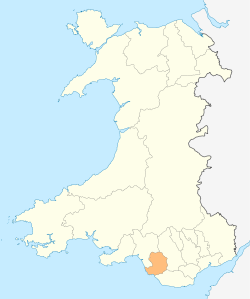Bridgend
Bridgend (English: /brɪˈdʒɛnd/; Welsh: Pen-y-bont ar Ogwr or just Pen-y-bont, meaning "the end (or head) of the bridge on the Ogmore")[2] is a town in Bridgend County Borough in Wales, 20 miles (32 km) west of the capital Cardiff and 20 miles (32 km) east of Swansea. The river crossed by the original bridge, which gave the town its name, is the River Ogmore, but the River Ewenny also passes to the south of the town.
Bridgend
| |
|---|---|
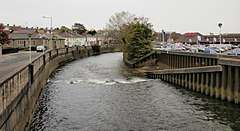 The Ogmore River. To the left of the river is Quarella Road; to the right, a superstore and car park | |
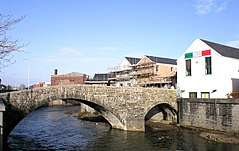 The Old Bridge was built in 1425, repaired in 1775 and restored in 2005 | |
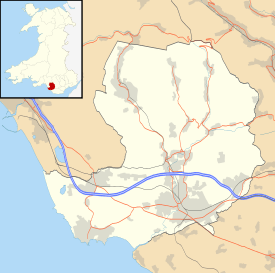 Bridgend Location within Bridgend | |
| Population | 49,404 (April 2011)[1] |
| OS grid reference | SS905805 |
| Community | |
| Principal area |
|
| Ceremonial county | |
| Country | Wales |
| Sovereign state | United Kingdom |
| Post town | BRIDGEND |
| Postcode district | CF31 |
| Dialling code | 01656 |
| Police | South Wales |
| Fire | South Wales |
| Ambulance | Welsh |
| UK Parliament | |
| Senedd Cymru – Welsh Parliament |
|
Historically a part of Glamorgan, Bridgend has greatly expanded in size since the early 1980s – the 2001 census recorded a population of 39,429 for the town[1] and the 2011 census reported that the Bridgend Local Authority had a population of 139,200 – up from 128,700 in 2001. This 8.2% increase was the largest increase in Wales except for Cardiff. The town is undergoing a redevelopment project, with the town centre mainly pedestrianised and ongoing works including Brackla Street Centre redevelopment to Bridgend Shopping Centre, Rhiw Car Park redevelopment, ongoing public realm improvements and the upgrade of the Bridgend Life Centre and demolition of Sunnyside offices to accommodate a large retirement complex.
History
Prehistoric and Roman
Several prehistoric burial mounds have been found in the vicinity of Bridgend, suggesting that the area was settled before Roman times. The A48 between Bridgend and Cowbridge has a portion, known locally as "Crack Hill", a Roman road and the 'Golden Mile' where it is believed Roman soldiers were lined up to be paid. The Vale of Glamorgan would have been a natural low-level route west to the Roman fort and harbour at Neath (Nidum) from settlements in the east like Cardiff and Caerleon (Isca).
Norman invasion

In the decades after the Norman conquest of Anglo-Saxon England in 1066, the Normans looked westwards to create new seats for lords loyal to William the Conqueror. Groups of Norman barons arrived in Wales, and in the south and east created what would later become the Welsh Marches, while the north and west remained largely unconquered.
At Coity, the local Welsh chieftain Morgan Gam already had a stronghold. Sometime in the 11th century, Norman Lord Payn de Turberville approached Morgan to turn over control of Coity Castle to Turberville. Morgan Gam agreed, on condition that Turberville either fought Morgan for the land, or took Gam's daughter Sybil's hand in marriage. Turberville married Sybil and became Lord of Coity, and rebuilt the castle.
Newcastle Castle (on Newcastle Hill, overlooking the town centre, 1106) and Ogmore Castle (1116) were built by Robert Fitzhamon and William de Londres, respectively.[3][4] About 2 miles (3 km) north-east of Ogmore Castle, Maurice de Londres founded the fortified Benedictine Ewenny Priory in 1141.[5]
These three castles provided a "defensive triangle" for the area – a quadrilateral if Ewenny Priory is included.
Early development
Bridgend developed at a ford on the River Ogmore, which was on the main route between east and west Wales. Just north of the town is the confluence of three rivers, the Ogmore, the Llynfi, and the Garw. South of Bridgend, the River Ewenny merges with the River Ogmore and flows into the Bristol Channel. In the 15th century, a stone bridge was built as a permanent connection between the two sides of the Ogmore (and was later rebuilt). Originally, this bridge had four arches, but in the 18th century, a massive flood washed two of them away. The rest of the bridge still stands and remains a focal point of the town: aesthetic restoration took place in 2006.
Bridgend grew rapidly into an agricultural town. It became an important market town, a status it retained until the late 20th century.
Industrial era
The discovery of coal in the South Wales Valleys north of Bridgend had a massive impact on the town. The first coal mining operations opened north of Bridgend in the 17th century; the Llynfi Valley was the first to be industrialised. Bridgend itself never had coal deposits and remained a market town for some time, but the valleys of the three rivers grew into an important part of the South Wales coalfields. Ironworks and brickworks (notably at Tondu) were also established in the same period by John Bedford, although the ironworks faltered after his death and ceased operating entirely in 1836.
The Great Western Railway arrived and Bridgend was at the junction between the main London to Fishguard line and the branch to the three valleys. Frequent coal trains took coal down the valleys; and when the Vale of Glamorgan railway opened, coal could be sent directly to port at Barry or via other branch lines to Porthcawl.
Several quarries opened in and around Bridgend town centre; some remnants of these can still be seen today near Brackla. An engine works was opened in the town and a larger farmers' market also opened in the town centre, where it remained until the 1970s.
In 1801, the population of what is now Bridgend County was around 6000. By the beginning of the 20th century this had risen to 61,000. By this time Bridgend was a bustling market town with prosperous valleys to the north, a thriving community and good links to other towns and cities.
Second World War
In the Second World War, Bridgend had a prisoner of war (POW) camp at Island Farm and a large munitions factory (ROF Bridgend – known as the "Admiralty") at Waterton, as well as a large underground munitions storage base at Brackla (known as the 8Xs). This was an overspill of the Royal Arsenal, Woolwich.
At its peak, the arsenal had 40,000 workers, many of them women. Large numbers of them were transported by bus from the Rhondda and the valleys.
The factory complex had three sites in Bridgend, all linked together by a large network of railways. Many reminders of the factory sites remain to this day – Brackla Ordnance Site.
In March 1945, 87 POWs from Island Farm escaped through a tunnel, but all were recaptured.[6] While Bridgend was as important during the war as any other part of Wales, and although it was photographed by the Luftwaffe, it was never blitzed, although the area immediately around Bridgend did suffer bombing raids. The admiralty ceased full-scale production in December 1945 after five years. Two of the munitions-storage magazines in the Brackla ROF site were converted to a regional government headquarters during the Cold War as part of the UK continuity of government plans.[7] It is now in the hands of a private company.
After the war
Bridgend remained a solid market town after the war. In 1948, Newbridge Fields (a short distance from the town centre) hosted the 1948 National Eisteddfod.
In 1960, the River Ogmore burst its banks and flooded the town centre. Subsequent floods and extreme weather led the Welsh Water Authority to develop concrete flood defence walls along the banks of the River Ogmore in the town centre. The town centre has not been flooded since. During this time, Bridgend was chosen to become the headquarters for South Wales Police. This action was ideal as geographically, Bridgend stands equidistantly between Swansea to the west and Cardiff to the east.
The Beeching cuts of the 1960s had the loss of passenger rail links in the Vale of Glamorgan and to the northern valleys. The Vale of Glamorgan link to Barry via Rhoose was reinstated in June 2005.
In the 1970s, Bridgend began to see the catalyst of arguably its biggest growth period. The "missing section" of the M4 motorway was constructed around the town, plans were afoot to change the Waterton Admiralty into an industrial estate, and the water supply was improved including new sewage treatment works near Ogmore. Two major multinational corporations, the Ford Motor Company and Sony, set up factories in or on the outskirts of the new Bridgend Industrial Estate (former Waterton Arsenal).
The development of the Brackla Housing Estate in the 1980s, housing developments at Broadlands to the south-west of the town centre and the continuing expansion of Brackla to the north-east have caused Bridgend's population to swell dramatically. Due to this, traffic congestion and a lack of parking facilities within the town have become important issues in the area. In 1997, a new link road/bypass was built to link the town centre directly to the M4 motorway, as well as redirect traffic around the town centre.
A new Securicor-operated prison (HM Parc Prison) was built near Coity in the late 1990s. The prison opened in November 1997.
The McArthur Glen Designer Outlet opened in 1998.
New millennium
Objective 1 investment in regeneration and public realm improvements has led to the pedestrianisation of the town centre and the restoration of some buildings.[8] Some local traders have argued that this has damaged trade due to a lack of access by taxis and the disabled.[9] Car parking provision and pricing have also been a concern to retailers with calls for free or reduced-price parking to increase town centre visits.[10]
To counteract the dominance of Tesco in the area, Asda were granted planning permission for a new superstore near the town centre. The store was opened on 31 March 2008 by the local MP, and players from Bridgend Ravens. Over 1500 customers were thought to have walked through the new doors to take a look around the new store.
In 2004, an award-winning new bus station was constructed and traffic movements around the town centre were altered. Local committees, together with the council, started to use the pedestrianisation of the town centre to its advantage, culminating in several fairs including Continental Markets, Celtic Festivals, a small Mardi-Gras, and seasonal markets and events. Bridgend Council estimated in 2009 that these events have brought 900,000 visitors to the town and generated around £53 million for the local economy.[11]

About £2.5 million of European funding was used to create a "riverside cafe culture" by constructing a walkway along the River Ogmore,[12] which was completed in March 2009.
Future developments

Construction on a 1500-home sustainable "village" at Parc Derwen near Coity began in 2011. The scheme is a collaboration between several house-builders and public bodies including the National Assembly, and has been planned with strict guidelines regarding architecture and the environment. Concerns exist from Coity in particular that this development may impact on their village's identity.[13]
Studies have been carried out by the local council with a view to improving retail provision in the town centre. Attracting bigger high-street chains to the town, such as Marks & Spencer, Next, and Debenhams is seen as key to this.[14]
At Elder Yard, a derelict Grade II-listed building in the heart of the town centre is due to be converted to a restaurant and provide the impetus for other improvements there, including a public courtyard and extra retail and leisure provision.[15]
Politics
As of June 2016, the local Member of Parliament is Madeleine Moon (Labour), the Welsh Assembly Member for Bridgend is Carwyn Jones AM (Labour) along with regional AMs (for South West Wales) Suzy Davies AM (Conservative), Bethan Jenkins AM (Plaid Cymru), Dai Lloyd AM (Plaid Cymru) and Caroline Jones AM (Brexit Party). Carwyn Jones was First Minister of Wales from 10 December 2009 until 12 December 2018.
Local government
Bridgend County Borough Council is led by the Welsh Labour Party, which has been running a minority administration since the May 2017 local elections. After the 2012 election, the council was made up of 39 Labour councillors, 10 Independents, 3 Liberal Democrats, 1 Conservative and 1 Plaid Cymru.[16] The Youth Mayor of Bridgend County Borough as of 2017 is Niamh Gwilym, and the Deputy Youth Mayor is Leigh Williams.[17]
Bridgend was an electoral ward to Glamorgan County Council from 1889 to 1974, electing the Earl of Dunraven as its first representative. Since 1995 the town has been covered by three wards to Bridgend County Borough Council, Morfa, Oldcastle and Newcastle, which each elect two councillors.[18]
At the Town Council level, Bridgend is represented by nineteen town councillors on Bridgend Town Council, elected from the three town wards of Morfa, Oldcastle and Newcastle.[19]
Economy
Bridgend's Travel to Work Area has expanded since 1991 and the 2001-based area now incorporates the western part of the Vale of Glamorgan.[20]
Bridgend recovered quickly from the decline of traditional industries, particularly coal-mining due to other alternative forms of employment. Wages are generally higher here than in other parts of the South Wales valleys. There are large industrial estates at Bridgend and Waterton (formerly Waterton Admiralty) which host a number of small-scale and multi-national companies, mainly manufacturing.
Ford's engine plant near Waterton employs around 2000 workers and is one of the area's largest employers, working on range of low carbon "EcoBoost" engines. The plant has won praise from Peter Mandelson who in January 2009 described it as "a top-of-the-class, world-beating engine production plant." Ford has invested £315million in the Bridgend plant over 5 years.[21]
IT Consultancy Group CGI have an office in Bridgend, and Lidl has also set up its Welsh headquarters and distribution site at Waterton. Zoobiotic, a company specialising in maggot therapy, has its facility near Bridgend town centre. Also, since 1983, famous dart board producer Winmau has based its global headquarters in Bridgend.
Others include Ortho-Clinical Diagnostics, Staedtler, engineering consultancy Skanska, aeronautic maintenance and project management company TES Aviation and home accessories manufacturer Dekor plc. The Semiconductor Photomask Company, Photronics Inc, has had a manufacturing operation for the last 20 years at the Ewenny Science Park.
However, there have been significant economic blows to Bridgend including Sony's closure of the Bridgend plant and downsizing of the Pencoed plant. The plant is still Sony's biggest in the UK despite this. Other manufacturers to have pulled out of the area include Wrigley Company and Dairy Farmers of Britain which went into receivership in June 2009.
Bridgend has a lack of high-wage service jobs; however the retail sector in particular provides a large proportion of employment in the town and borough. In 2008, there were 13,100 people in Bridgend County working in construction and manufacturing, while 42,900 were working in the service sector.[22]
Sub-regional GVA for the Bridgend & Neath Port Talbot NUTS3 region stood at £12,402 per capita in 2006 ($23,191 at June 2006 values). This figure represents 65% of the UK GVA per capita, 87% of Welsh GVA per capita (£14,226) and 103% of West Wales & The Valleys GVA per capita (£12,071).
Gross disposable income for Bridgend & Neath Port Talbot in 2006 stood at £3,338 million or £12,379 per head. This was 88% of UK per head figure (£14,053) and slightly above the Welsh per head figure (£12,366).
In 2008, the average full-time gross weekly earnings in Swansea, Bridgend & Neath Port Talbot was £484.20 (£531.70 for men, £426.10 for women). This was 97% of the Welsh average (£498.10).
In the first half of 2009, unemployment in Bridgend County Borough stood at 8.9%[23] and economic inactivity stood at 21.4%.[24]
The percentage of workless households in December 2008 stood at 20.6% compared to the UK average of 16% and the Welsh average of 18.8%.[25]
Shopping
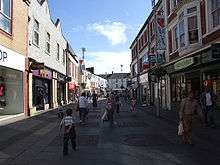
In the town centre the main retail shopping areas are the Rhiw Shopping Centre (containing Bridgend Market), Adare Street, Caroline Street, Derwen Road, Nolton Street, Queen Street, Dunraven Place, Market Street and Cheapside (home of the Brackla Street Centre and Asda store). These are near the bus and railway stations and pay and display car parks.
There are out-of-town shopping areas at Waterton, near the A473, on Cowbridge Road and at The Derwen, Junction 36 of the M4, home to the Bridgend Designer Outlet.
Transport
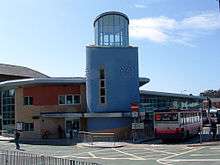
Bridgend railway station has regular services to Cardiff Central, Bristol Parkway and London Paddington to the east; Port Talbot Parkway, Neath, Swansea and the West Wales Line to the west; and Maesteg to the north. There are also services to Manchester Piccadilly. Bridgend is the western terminus of the Vale of Glamorgan Line which reopened to passenger traffic in 2005.
Wildmill railway station, about 1 mile (2 km) north of Bridgend railway station, serves the estates of Wildmill, Pendre and Litchard and is on the Bridgend-Maesteg branch line. A park and ride station at Brackla, about 1.5 miles (2.4 km) south-east of Bridgend railway station is planned and is due to be constructed once capacity improvements have been made to the South Wales Main Line. Services to a new railway station in Llanharan began in December 2007.[26]
Bridgend bus station has services to urban and rural areas in South Wales. Most services are operated by First Cymru.
An east–west cycle route has been constructed from Brackla through to Broadlands and into Cefn Glas. Bridgend is on the National Cycle Route and there are off-road spurs from the Celtic Trail to the town centre and a community route in the Ogmore Valley. Glyncorrwg and the Afan Valley about 12 miles (19 km) north of Bridgend near Maesteg is famed for its mountain bike trails, considered amongst the best in Europe.
For scheduled and chartered air travel, Bridgend is served by Cardiff International Airport, to which there are direct rail and bus services.
Education
Bridgend town has three comprehensive schools: Archbishop McGrath Catholic Comprehensive, Brynteg Comprehensive and Bryntirion Comprehensive. Brynteg generally serves the area east of the River Ogmore, while Bryntirion serves the areas west of the river. Brynteg is renowned for its rugby alumni, including J.P.R. Williams, Rob Howley, Gavin Henson, Mike Hall and Dafydd James; many talented athletes at other local schools join Brynteg to play for the school in the Welsh School Rugby Union leagues. The school has produced several Welsh rugby union internationals, and prominent athletes in other sports have also attended, including top female cyclist Nicole Cooke. Bryntirion has also produced its fair share of sporting talent, notably Gareth Llewellyn and triathlete Marc Jenkins. Archbishop McGrath School covers the whole of the county, and moved to a new campus at Brackla in 2011.
At least nine primary, junior schools, and infant schools are in the town, though several of the junior and infant schools have merged to form single primary schools in recent years.
Also, two special-educational needs schools are there: Heronsbridge School which is linked with Brynteg Comprehensive School and at the back of Bridgend College. It is for students of primary and secondary school ages with severe learning disabilities. Another school, Ysgol Bryn Castell, offers education for Key Stage 1–4 students with moderate to severe learning disabilities; it is linked with Bryntirion Comprehensive School and has opened up a satellite unit at Cynffig Comprehensive School, a few miles west of Bridgend.
Bridgend College is the town's further education and higher education provider; it primarily offers vocational courses and GCSEs. It attracts school-leavers from as far as Swansea and Cardiff. It offers a range of higher-education courses such as Postgraduate Certificate in Education, Higher National Certificate, and Higher National Diploma in various subjects and master's programmes at its Queens Road campus on Bridgend Industrial Estate. These are mainly franchised from the University of South Wales. The Pencoed Campus has a focus on sport, animal care, and horticulture, and Maesteg Campus offers more community-based programmes.
Bridgend College has its own residence for students aged 16+ with learning difficulties and physical disabilities who come to the college from all over Wales.
Health
Since the closure and redevelopment of Bridgend General Hospital in the 1990s, acute-care and accident and emergency services have been provided by the Princess of Wales Hospital. GP's surgeries are scattered throughout the town, as are dentists. There is also a large psychiatric hospital, Glanrhyd Hospital, near Pen-y-fai.[27]
Culture
Nightlife
Several pubs, restaurants and a nightclub are located within the town centre.
In December 2008, Bridgend Council introduced its first alcohol-free zone, restricting the consumption of alcohol to pubs, clubs, and other licensed premises in the town centre to help address alcohol-related issues.[28] CCTV is in operation throughout the town centre, and usually police have a presence of some form. Since July 2007, the streets of Bridgend are also patrolled on Friday and Saturday evenings by Street Pastors, an inter-denominational church response to urban problems, engaging with people on the streets.[29]
Music
Bridgend is home to a number of punk rock, indie rock, heavy metal, and emo music acts that are playing the clubs of the area, making it a prominent part of the South Wales music scene. Metalcore band Bullet for My Valentine and Funeral for a Friend are notable underground rock/metal acts from the borough along with global export Jayce Lewis, Lostprophets and The Automatic all receiving mainstream notability.[30][31][32] There are several smaller venues in and around the town centre including The New Angel Inn, The Railway Inn, Barracudas and Sapphires, which all host a number of open-mic nights. Bryan Adams played to a 15,000 crowd at Brewery Field in the town centre on 2 June 2006. The Recreation Centre has also hosted acts such as Fall Out Boy and Bring Me the Horizon.
Eisteddfodau
Bridgend hosted the National Eisteddfod in 1948. Bridgend County hosted the Urdd Gobaith Cymru National Eisteddfod in 2017.
Media
Bridgend has its own commercial radio station: 106.3 Bridge FM, and is the location of Internet-based radio station Celtica radio. The main local newspaper is The Glamorgan Gazette, although a free newspaper, The Recorder, has increased its circulation in recent times. Around Town magazine is the free local lifestyle magazine for Bridgend.
Sport

Rugby union
Bridgend Ravens Bridgend Ravens (formally Bridgend RFC) are a semi-professional rugby union which formed in 1878 and play in the Welsh Premier Division. They play their home matches at the Brewery Field, which has been their home on and off since 1920. The club have been Welsh champions five times and have won the WRU Challenge Cup on two occasions, whilst also winning the WRU Division One West league in 2011 and numerous sevens competitions over the course of their existence. They have also played against international teams, New Zealand won on their visit in 1978, but Bridgend have beaten Italy, Western Samoa and Australia. The club has also hosted international matches at women and age grade.
Bridgend Athletic Bridgend Athletic RFC was reformed in 1972, after the Bridgend Youth team members in that year wanted to form a senior team so they didn't have to go their separate ways into senior rugby, hence the formation of the club which had previously existed up to 1939. The club become full members of the Welsh Rugby Union in 1983. The club were promoted from Division 5 Central in 2001, were WRU Division Four East Champions in 2002, were then promoted from Division 3 to WRU Division Two West in 2003 through the league organisation and were promoted to Division 1 in 2004. They have suffered relegation from that league once, but bounced back in 2009, winning WRU Division Two West. They play in WRU Division One West.
Bridgend Sports Bridgend Sports Rugby Football Club is a Welsh rugby union team based in Bridgend. Formed in 1938 by Victor Blick, the team survived the cessation of club rugby in Wales between 1939 and 1945, during the Second World War. There have been in existence at least two other clubs in Bridgend throughout the club's history providing local competition. The club is a member of the Welsh Rugby Union and play in the WRU Division Four South East. They won the Glamorgan County Silver Ball Trophy on three successive years between 1979 and 1981, and were champions of WRU Division Five South Central in 2010.
Celtic Warriors
The Celtic Warriors, formed in 2003, are a defunct regional rugby union team that was mainly based at the Brewery Field in Bridgend. When regional rugby was enforced by the Welsh Rugby Union, Bridgend RFC and Pontypridd RFC, who were both professional clubs at the time, merged to create the Celtic Warriors as one of the five new regional rugby teams in Wales. However, they were dissolved after one season due to financial problems that had plagued the club. Pontypridd RFC had sold their share of the region early on due to their own financial difficulties, with the remaining share which had been owned by Bridgend RFC, being sold off to the Welsh Rugby Union at the end of the season. This led to the winding up of the Celtic Warriors region by the WRU, as there was not enough money to keep the region afloat.[34] There were high points for the region: 10,000 turned up to watch them face European champions-in-waiting London Wasps and even beat the Wasps 9–14[35] at Adam's Park a week earlier. The team finished 4th out of 12 in the Celtic League in their only season of existence.
Ospreys Rugby
The Ospreys were formed in 2003 after the merger of Neath RFC and Swansea RFC, which took place after the Welsh Rugby Union forced through regional rugby as the top level of Welsh rugby. Bridgend became part of this region following the demise of the Celtic Warriors. Although the Ospreys play their home matches at the Liberty Stadium in Swansea, since 2010 they have played their home Anglo-Welsh Cup home games at the Brewery Field, which is normally two games a season.
Soccer
Bridgend had two football teams, Bridgend Town A.F.C., and a Bridgend suburb side Bryntirion Athletic F.C. that played in the Welsh Football League First Division. Bridgend Town AFC from 2009 played at The Brewery Field (The Football Club purchased The Brewery Field in 2009) as the club sold its ground at Coychurch Road ground due to works in conjunction with the new Asda store. In 2013, the two clubs joined to form Pen-y-Bont F.C. who, following promotion in 2019, play in the Welsh Premier League, the top level of Welsh football. They are currently managed by Rhys Griffiths.
Bridgend's geographical position means South Wales rivals Cardiff City and Swansea City pick up support from the town.
Rugby league
Bridgend was home to Super League rugby league team the Crusaders, who were based at the Brewery Field, home of rugby union club, Bridgend RFC. This side was considered by a few to be a replacement for the Celtic Warriors rugby union side after their controversial disbanding in 2004 but also built up a loyal following in their own right. The Crusaders' application for a Super League licence was granted by the Rugby Football League on 22 July 2008. The decision elevated the club from National League One to compete in Super League XIV from 2009.
For the 2010 Super League season, Crusaders initially announced they would play at Newport's Rodney Parade ground for two seasons. However, in the run up to the new season the Celtic Crusaders franchise was sold by owner Leighton Samuel to Wrexham Football Club parent company, Wrexham Village Ltd and the side moved to Wrexham, playing home fixtures at The Racecourse Ground.[36]
Bridgend's second rugby league side is the Bridgend Blue Bulls, one the UK's most successful amateur clubs having won two UK national amateur titles in four years and Welsh Champions five years in succession. The Bulls played at Coychurch Road but following the announcement about the setting up of the Celtic Crusaders they were invited to play at the Brewery Field by the owner Leighton Samuel. One year on they were refused permission to continue playing at the Brewery Field in the middle of the season. They were then aided by Porthcawl RFC and staged the remaining 2006 home games at the Porthcawl ground. Subsequently, Porthcawl RFC have become their regular home and have even staged an amateur rugby league international there during 2008 (Wales v Ireland).
Notable people
- See Category:People from Bridgend and Category:People from Bridgend County Borough
- Gerald Battrick (tennis player)
- Jonathan Brown (footballer)
- Downtown Julie Brown (actress)
- Steve Brace (Olympic marathon runner)
- Paul Burston (author and journalist)
- Lee Byrne (rugby player)
- Nicole Cooke (cyclist)
- Peter Cottrell (historian and writer)
- Danie Centric (singer)
- Matt Crowell (footballer)
- Aled Davies (Paralympian)
- Deddie Davies (actor)
- Rhys Davies (European Tour golfer)
- Rhys Day (footballer)
- Ryan Day (snooker player)
- Leondre Devries (rapper)
- Mark Donovan (actor)
- Huw Edwards (journalist and newsreader)
- Rhian Edwards (poet)
- David Emanuel (fashion designer)
- Scott Gibbs (rugby player)
- Ray Giles (rugby player)
- Michael Hall (rugby player)
- Gavin Henson (rugby player)
- Robert Howley (rugby player)
- Jonathan Humphreys (rugby player)
- Dafydd James (rugby player)
- Marc Jenkins (Olympic triathlete)
- Alex Jones (cricketer)
- Carwyn Jones (politician, First Minister of Wales)
- Ruth Jones (actress)
- Amanda Levete (architect)
- Jayce Lewis (musician/producer)
- Gareth Llewellyn (Rugby player)
- Sean McCarthy (footballer)
- Howard Marks (drug smuggler and author)
- William Morgan (physician, physicist and statistician)
- Sir Morien Morgan (aeronautical engineer)
- Josh Navidi (rugby player)
- Alan Phillips (rugby player)
- Ben Phillips (rugby player)
- Leeroy Reed (musician)
- Billy Rees (footballer)
- Nathan Stephens (Paralympian)
- Steve Strange (singer)
- Owen Teale (actor)
- Gareth Thomas (rugby player)
- Helen Tucker (2008 World Triathlon champion)
- Matthew Tuck (Singer)
- Bradley Wadlan (cricketer)
- Rhys Webb (rugby player)
- David Williams (crime writer)
- J. J. Williams (rugby player)
- J.P.R. Williams (rugby player)
Bands associated with Bridgend
See also
- Bridgend suicide incidents
- Bridgend (UK Parliament constituency) Bridgend County
References
- "Key Statistics for urban areas in England and Wales". Census 2011. UK Office for National Statistics. Archived from the original on 18 October 2014. Retrieved 4 September 2013.
- Mills, David (2011), A Dictionary of British Place-Names, Oxford: Oxford University Press, p. 76, ISBN 9780199609086
- "Newcastle Castle, Bridgend". Coflein. Royal Commission on the Ancient and Historic Monuments of Wales. 11 March 2008. Retrieved 28 July 2012.
- "Ogmore Castle". Coflein. Royal Commission on the Ancient and Historic Monuments of Wales. 10 March 2008. Retrieved 28 July 2012.
- "Ewenny and St Brides Major – Parish Control". Ewenny.org.uk. Archived from the original on 8 May 2006. Retrieved 6 August 2011.
- Rees-Hughes, L; Pringle, JK; Russill, N; Wisniewski, K; Doyle, P (2017). "Multi-disciplinary investigations at PoW Camp 198, Bridgend, S. Wales: site of a mass escape in March 1945" (PDF). Journal of Conflict Archaeology. x (2–3): 166–191. doi:10.1080/15740773.2017.1357900.
- "Brackla RGHQ". Subbrit.org.uk. Retrieved 6 August 2011.
- Town Centre Streetscene Archived 27 April 2011 at the Wayback Machine Bridgend County Council
- Angry trader calls for town centre ‘shutdown’ to bring back traffic WalesOnline 25 June 2009
- "Free parking may tempt shoppers back into town". WalesOnline. 22 January 2009.
- Bridgend County Borough Council Report to Town and Community Council Forum, 14 April 2009
- River Ogmore Walkway & Bridge, Bridgend Archived 24 July 2011 at the Wayback Machine Bridgend County Borough Council
- Bypass drives ‘village for the 21st century’ ahead WalesOnline 26 February 2008
- Can high street giants revive Bridgend? 28 February 2008
- Unveiled – the master plan for town centre WalesOnline, 6 August 2009
- "2012 Local Election Results". Bridgend.gov.uk. 4 May 2012. Archived from the original on 30 August 2012. Retrieved 5 May 2012.
- "Bridgend Youth Council". Bridgend.gov.uk. 13 June 2011. Archived from the original on 27 September 2011. Retrieved 8 August 2011.
- "Bridgend County Borough Council Election Results 1995–2012" (PDF). The Elections Centre (Plymouth University). Retrieved 18 May 2019.
- "Wards and Councillors". Bridgend Town Council. Retrieved 4 April 2019.
- "National Statistics, Introduction to the 2001-based Travel-to-Work Areas" (PDF). Archived from the original (PDF) on 5 March 2009. Retrieved 6 August 2011.
- Ford Bridgend praised by Mandelson WalesOnline, 16 January 2009
- StatsWales 2008 employment report
- StatsWales Annual unemployment Rate Archived 18 July 2011 at the Wayback Machine 30 June 2009
- StatsWales Annual economic inactivity rates Archived 18 July 2011 at the Wayback Machine 20 March 2009
- StatsWales; Workless households by household status 31 December 2008
- "Village back on track 43 years on". BBC News. 10 December 2007. Retrieved 26 April 2010.
- "Glanrhyd Hospital". County Asylums. Retrieved 26 February 2019.
- Alcohol-free zone set to begin Archived 3 May 2010 at the Wayback Machine, Bridgend County Borough Council, 26 November 2008
- "Bridgend". Street Pastors. 24 July 2008.
- "Musician's surprise at Asia hit". 17 September 2009 – via news.bbc.co.uk.
- "Big in India, Planet Wales – BBC One". BBC.
- "Lostprophets are finding their way to pop success".
- "News – Cardiff News – Libyan dictator eyes twin town". WalesOnline. 25 September 2008.
- "WRU axe falls on Warriors". BBC Website. BBC. Retrieved 25 September 2013.
- "Wasps stung by try on the Celtic fringe". Guardian. 12 January 2004. Retrieved 14 October 2013.
- "BBC SPORT | Rugby League | My Club | Celtic Crusaders | Crusaders to make Newport switch". BBC News. 21 August 2009. Retrieved 6 August 2011.
External links
| Wikimedia Commons has media related to Bridgend. |
| Wikisource has the text of the 1911 Encyclopædia Britannica article Bridgend. |
